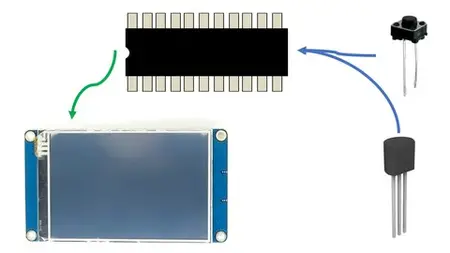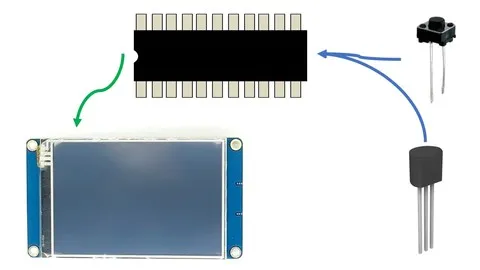Nextion Touch Screen With Pic16F877A Tutorials Collection.
Published 11/2024
MP4 | Video: h264, 1920x1080 | Audio: AAC, 44.1 KHz
Language: English | Size: 2.73 GB | Duration: 2h 33m
Published 11/2024
MP4 | Video: h264, 1920x1080 | Audio: AAC, 44.1 KHz
Language: English | Size: 2.73 GB | Duration: 2h 33m
Interfacing Nextion touch screen with PIC microcontroller to develop various useful projects.
What you'll learn
You will learn how to interface a Nextion touch screen with a PIC16F877A microcontroller.
You will learn how to design a Nextion display on Nextion editor and then use this to assign varialbles which you will address using PIC microcontroller.
You will learn how to program PIC16F877A UART Port to interface with a Nextion touch screen.
You will learn how to make useful projects using PIC microcontroller and a Nextion display like a temperature measurement system, LED triggering system etc.
Requirements
Beginner level and interest in microcontrollers and electronics.
Interest in developing HMI for embedded systems using touch screens like Nextion or DWIn etc.
Description
This course will teach you how you can interface a PIC microcontroller with a state of the art Nextion touch screens. This course covers PIC16F877A interface with Nextion touch displays using MikroC for PIC compiler. We will be using PICKIT programmer tool with PICKIT to burn the code. Now guys, in this course first 3 sections will teach you about the basics of PIC microcontroller. You will learn what is a PIC16F877A microcontroller, theory about its specifications and pins/ports configurations, how to download and install a compiler called mikroC for PIC, how to download and install a PICKIT programmer tool to make sure that you can read and write the device and then there will be lectures leading you to how you set up a PIC microcontroller for the first run and then after that we will come to our main topic of Nextion displays interface with PIC16F877A. In the first tutorial we will be just sending a text to the nextion screen. Now to achieve this first we will download and install nextion editor from the offical nextion website. After that we will be developing a GUI for the Nextion screen on Nextion editor, after that we will assign variable names in the editor and then we will write our PIC code by addressing these variables names. Now guys to interface a microcontroller with the Nextion screen we will be using Nextion datasheets from Nextion website. We will do our coding as per there demand. Then after that we will send a text for PIC to Nextion. Similarly, other 3 lectures will give you more know how on how to develop more useful projects using Nextion with PIC.Now to make things further clear guys. Once you go through the course you will notice that. This course was made with PIC16F877A microcontroller but the great thing is all the PIC microcontrollers have exactly same coding with the mikroC for PIC compilers. This means if you learnt this with PIC16F877A then you can use same code with differnet (pin layout settings as per the selected microcontroller) PIC microcontrollers including PIC10, PIC12,PIC16,PIC18,PIC24,PIC32,dsPICs etc. If you guys have any problem during the course please feel free to leave a message.Course lecture list:Introduction to PIC16F877A microcontroller.Lecture 1: Introduction to PIC16F877A microcontroller.Lecture 2: Get familiar with PINS and PORTS configuration of PIC16F877A microcontroller.Lecture 3: Setting up a PIC16F877A for first code programming using PICKIT.Downloading and installing MikroC for PIC.Lecture 4: Download and install mikroC for PIC compiler.Downloading and installing PICKIT programming tool.Lecture 5: Downloading and installing PICKIT programming tool.Nextion Touch displays based projects using PIC16F877A microcontroller.Lecture 6: Displaying your first text from PIC16F877A to the Nextion screen.Lecture 7: Turning LEDs ON and OFF using Nextion touch screen using PIC16F877A MCU.Lecture 8: Running multiple counters on Nextion touch screen using PIc16F877A MCU.Lecture 9: Room temperature measurement system using Nextion , PIC16F877A & LM35.RegardsLearning Microcontrollers
Overview
Section 1: Introduction to PIC16F877A microcontroller.
Lecture 1 Introduction to PIC16F877A microcontroller.
Lecture 2 Get familiar with PINS and PORTS configuration of PIC16F877A microcontroller.
Lecture 3 Setting up a PIC16F877A for first code programming using PICKIT.
Section 2: Downloading and installing MikroC for PIC.
Lecture 4 Download and install mikroC for PIC compiler.
Section 3: Downloading and installing PICKIT programming tool.
Lecture 5 Downloading and installing PICKIT programming tool.
Section 4: Nextion Touch displays based projects using PIC16F877A microcontroller.
Lecture 6 Displaying your first text from PIC16F877A to the Nextion screen.
Lecture 7 Turning LEDs ON and OFF using Nextion touch screen using PIC16F877A MCU.
Lecture 8 Running multiple counters on Nextion touch screen using PIc16F877A MCU.
Lecture 9 Room temperature measurement system using Nextion , PIC16F877A & LM35.
For beginners to learn How to program a PIC16F877A microcontroller using MikroC for PIC compiler to interface with Nextion touch screens and develop nextion touch display using Nextion editor to make useful projects for the commerical applications.,People willing to develop HMI for commercial and home use applications using microcontrollers.



